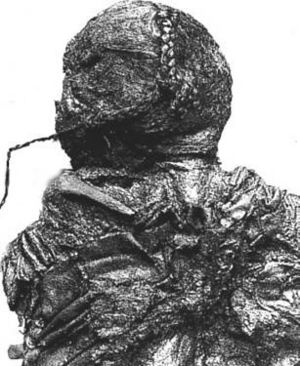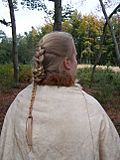Elling Woman facts for kids
Quick facts for kids
Elling Woman
|
|
|---|---|

Upper body of the Elling Woman
|
|
| Born | 375–175 BCE |
| Died | 350–150 BCE (aged 25) (approximate) |
| Cause of death | Hanging (presumably ritual sacrifice) |
| Body discovered | 1938 Silkeborg, Denmark |
The Elling Woman is an ancient body found preserved in a bog. She was discovered in 1938 in Denmark, near the town of Silkeborg. Her body is very old, dating back to the Nordic Iron Age.
Interestingly, the famous Tollund Man was found just 60 meters away from her. He was discovered twelve years after the Elling Woman. For a while, people thought the Elling Woman was a man. This mistake was even in a book called The Bog People by P.V. Glob.
How the Elling Woman Was Found
A local farmer named Jens Zakariasson found the Elling Woman's body. At first, he thought it was a drowned animal. This happened in 1938.
The body was wrapped in a cape made from sheepskin. A leather cloak was also tied around her legs. Her face was not well preserved. Also, there were no organs left inside her body.
Studying the Elling Woman
Scientists believe the Elling Woman was hanged. This is similar to how the Tollund Man is thought to have died. She likely died around 280 BCE during the Nordic Iron Age. This was also around the same time as the Tollund Man. However, we cannot be sure if they died at the exact same moment.
At first, it was hard to tell if the body was male or female. Luckily, her hair was still preserved. Later, X-rays were taken of her pelvis. These X-rays proved that she was indeed a female.
In 1978, experts looked at her body again using radiographs. These special X-ray images confirmed she was female. They also confirmed her age at death was about 25 years old. The Elling Woman is often recognized by her long, 90-centimeter braid. This braid was tied in a fancy knot. Many believe the Elling Woman was a human sacrifice. This means she might have been offered to gods as part of a religious ceremony.
Scientists also found that her bones seemed to have osteoporosis. This is a condition where bones become weak. But it was later understood that her bones were just demineralized. This happens often to bog bodies.
See also
 In Spanish: Mujer de Elling para niños
In Spanish: Mujer de Elling para niños



